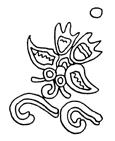Cocone Amoxtli
The Artists and the Need for
Culturally Sensitive Literature
Deborah Ramos, visual artist, and Ayme Almendarez, poet and playwright, joined creative energies, in 2005, to begin groundwork for a series of children’s books inspired by the ancient pictographic accordion-style books of Mexico called amoxtli (ah MOSH tli). The initial stages of their collaboration was supported, in 2006, by a Minnesota State Arts Board Cultural Community Partnership Grant.
Deborah and Ayme realized a need for more culturally sensitive literature that represents Chicanos/as and Mexicanos/as as creative and intelligent beings. The artists wish to offer children and adults a series of books that are engaging at various levels, and are free of the perpetuation of colonialist interpretations of indigenous Mexican history.
What does Cocone Amoxtli mean?
Cocone Amoxtli (co CO neh - ah MOSH tli) is Nahuatl (NAH waht), one of the original languages of Mexico, for “children’s book.†An important aspect of the Cocone Amoxtli Project is respectfulness towards ancient Mexihca (meh SHEE kah) teachings and concepts intended for the overall development of autonomous people throughout generations.
Escribir Pintando / “To Write by Paintingâ€
After a spiraling trajectory, that lasted for several hundred years, the Mexihca (also known as the “Aztec†People) traveled by foot from the region of Chicomoztoc (chee koh MOHZ tohk)—within North America— to establish, in 1325, Mexihco-Tenochtitlan (meh SHEE koh – te noch TEET lan)— renamed “Mexico City,†in the 16th century, by the invading society—in the middle of Lake Tetzcoco.
In 1519, Hernán Cortés invaded Mexihco-Tenochtitlan. His subordinates, stationed across the region, removed thousands of hand-painted books from the centers of education. The majority of the books were destroyed in fires that burned for up to four days and nights. Many books recreated later by captives of Spanish friars reflect colonialist intentions. Furthermore, some of the books that did not burn are now in museums and private collections in Europe.
Much of what is known and written today about ancestral Mexican people is based on post-colonial literature. However, many of the stories, songs and teachings have survived and continue to be passed throughout generations through the oral tradition.
In the mid-1900s, amatl underwent a rebirth that revitalized the relationship between indigenous Mexican people and their ancient paper.
Even though today some of the applications are new, they continue to relate to the original traditions.
Project Goal
Cocone Amoxtli, Children’s Book Project, exists to encourage a historical and cultural sensibility within children’s literature, regarding indigenous Mexican people, by the creation of a series of books that will combine oral tradition with visual concepts through a contemporary narrative accessible to a wide audience.
Contact Us!
[email protected]
www.myspace.com/coconehamox
We especially thank our advisors, sponsors, and volunteers.
Tlazohkamati!
